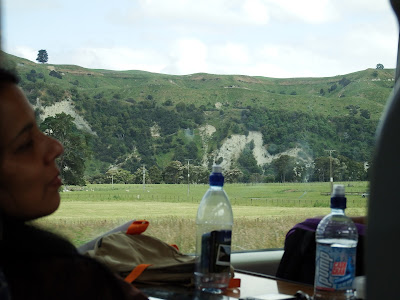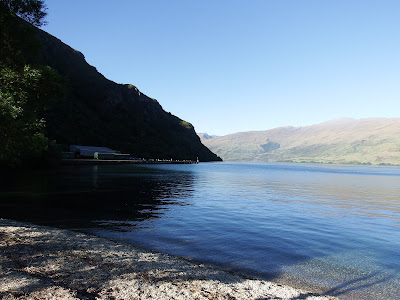A gorgeous day greeted our early departure from Auckland. We wanted to get ahead of the masses who would no doubt venture out, it being a Saturday, mid summer and a popular retreat for Kiwis and tourists alike.
One of the first features to attract my attention was the chalk white cliffs which were even more impressive in the morning sun. This rock is known as Ignimbrite. A close up look at the rock reveals an angular shaped blocks of pumice deposited in the form of ash from past cataclysmic
volcanic explosion(s). Normally this type of deposit surrounds a caldera. In this case with upheavals of land and seabed the original structure has long since been deformed and reformed.
 New Zealand is a continent in transition. Since its departure from Gondwanaland 85 million years ago it has undergone constant tectonic restructuring. Some parts of New Zealand are as much as 450 kilometres from their original locations. Volcanic eruptions have further shifted huge chunks of land vertically in the space of a few minutes, as we observed in Christchurch.
New Zealand is a continent in transition. Since its departure from Gondwanaland 85 million years ago it has undergone constant tectonic restructuring. Some parts of New Zealand are as much as 450 kilometres from their original locations. Volcanic eruptions have further shifted huge chunks of land vertically in the space of a few minutes, as we observed in Christchurch.Yet the sculpting influence of wind and water are evident here as well.. This relatively soft rock is subject to the relentless pounding surf, carving arches, shaping rocks, leaving a residue of soft whites sands as evidence of its innate artistic capacity.
The waters were too warm to resist.
This is the first time I went swimming and wondered what had taken me so long. I swam out to one of the big rocks (not this one here) and climbed on top and dived off. This was a reminder that swimming requires some conditioning and I found my self having to work at it to navigate the surf, swells and effects of tide. Never the less it was all fun and certainly worth the effort.
Aptly named Cathedral cove, this archway framed one of the most picturesque views I have seen while here in New Zealand. This proved to be just what I needed to rejuvenate from the emotional demands of the work. Arendje seems to enjoy it as much as I do, although the treks into some of these places makes her somewhat less excited.
The appeal of this beach explains the number of people present. We got here relatively early and a steady stream of trekkers continued to come as we headed back up the trail.
This view is taken from the trail head overlooking the islands off the coast. The Winters the couple to our left are our regular travelling companions. The young couple beside them is their daughter and son in law visiting from Salt Lake area.
A number of tourists and locals opt for a kayak or boat tours to the beach, certainly a less arduous way to get there. I saw a few working there way around this promontory. In fact in this picture were magfnified you might see them






















